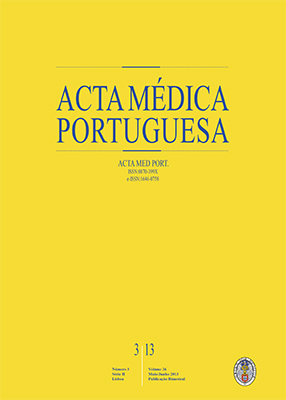Radiologic Anatomy of Arteriogenic Erectile Dysfunction: A Systematized Approach
DOI:
https://doi.org/10.20344/amp.4248Abstract
Introduction: Erectile Dysfunction is a highly prevalent disease and there is growing interest in its endovascular treatment. Due to the complexity of the male pelvic arterial system, thorough anatomical knowledge is paramount. We evaluated the applicability of the Yamaki classification with Computerized Tomography Angiography and Digital Subtraction Angiography in the evaluation of patients with arteriogenic Erectile Dysfunction, illustrating the arterial lesions that can cause Erectile Dysfunction.Methods: Single-center retrospective analysis of the Computerized Tomography Angiography and Digital Subtraction Angiography imaging findings in 21 male patients with suspected arteriogenic Erectile Dysfunction that underwent selective pelvic arterial embolization. Assessment of erectile function was achieved using the IIEF-5. The branching patterns of the Internal Iliac Artery were classified according to the Yamaki classification. The diagnosis of arteriogenic Erectile Dysfunction was based on the presence of atherosclerotic lesions (stenoses and/or occlusions) of the Internal Iliac Artery or the Internal Pudendal Arteries.
Results: The mean patient age was 67.2 years; with a mean IIEF of 10.6 points. Computerized Tomography Angiography and Digital Subtraction Angiography findings allowed classification of all the 42 pelvic sides according to the Yamaki classification. Twenty-four pelvic sides were classified as Group A (57%), 9 as Group B (21.5%) and 9 as Group C (21.5%). The Digital Subtraction Angiography detected 19 abnormal Internal Pudendal Arteries (with atherosclerotic lesions) (45%). The Computerized Tomography Angiography detected 24 abnormal Internal Pudendal Arteries (57%).
Conclusion: Computerized Tomography Angiography and Digital Subtraction Angiography findings of arteriogenic Erectile Dysfunction include stenotic and occlusive lesions of the Internal Iliac Artery and Internal Pudendal Artery. The Yamaki classification is radiologically reproducible and allows easy recognition of the Internal Pudendal Artery in patients with arteriogenic Erectile Dysfunction.
Downloads
Downloads
Published
How to Cite
Issue
Section
License
All the articles published in the AMP are open access and comply with the requirements of funding agencies or academic institutions. The AMP is governed by the terms of the Creative Commons ‘Attribution – Non-Commercial Use - (CC-BY-NC)’ license, regarding the use by third parties.
It is the author’s responsibility to obtain approval for the reproduction of figures, tables, etc. from other publications.
Upon acceptance of an article for publication, the authors will be asked to complete the ICMJE “Copyright Liability and Copyright Sharing Statement “(http://www.actamedicaportuguesa.com/info/AMP-NormasPublicacao.pdf) and the “Declaration of Potential Conflicts of Interest” (http:// www.icmje.org/conflicts-of-interest). An e-mail will be sent to the corresponding author to acknowledge receipt of the manuscript.
After publication, the authors are authorised to make their articles available in repositories of their institutions of origin, as long as they always mention where they were published and according to the Creative Commons license.









